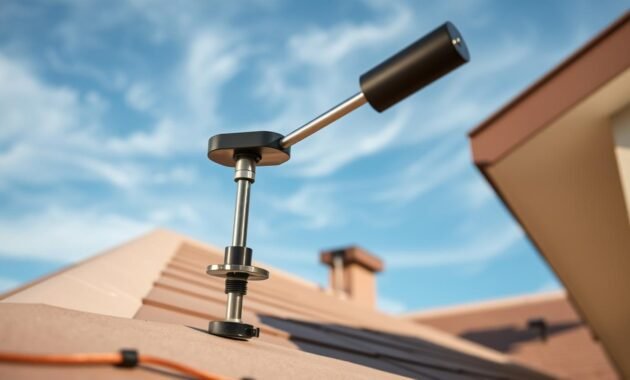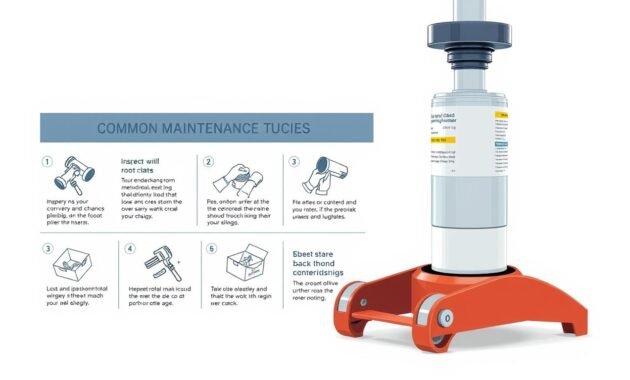Roofing projects can be very dangerous. DIY homeowners risk a lot without the right tools. Falls are the leading cause of death in construction, making up 33% of fatalities.
One wrong step on a steep roof can cause serious harm or lead to expensive problems. These issues might include water leaks, mold, and repairs that cost between $5,000 and $10,000.
Roof jacks are your best friend for safety. They offer a solid base, cutting accident risks by up to 50%. My guide will cover everything you need to know about roof jacks.
This includes their purpose and how to install them safely for your roof vent and flashing needs. Whether you’re a DIY enthusiast or just curious, I’ll make you feel confident and skilled in using roof jacks.
Understanding the Basics of Roof Jacks
Roof jacks are key parts of modern roofing systems. They help keep your home safe and strong. As a roofer, I’ve seen how they prevent damage and keep attic spaces safe.
Read also: Common Metal Roof Over Shingles Problems
Definition and Primary Functions
A roof jack is a special bracket for roof repairs or installations. It’s made from strong materials like metal or plastic. These materials can handle different weather conditions.
- Provide stable support during roofing work
- Create safe working platforms on steep roof surfaces
- Protect underlying roofing system components
- Distribute weight evenly across roof surfaces
Importance in Roofing Systems
Roof jacks are very important for a strong roofing system. They help avoid damage by spreading weight evenly. They also support during repairs and maintenance.
| Material | Durability | Typical Lifespan |
|---|---|---|
| Metal Roof Jacks | High | 10-15 years |
| Plastic Roof Jacks | Medium | 5-10 years |
Common Applications
Roof jacks are used in many situations. They’re great for home repairs and big construction projects. They also protect attic spaces and make sure work is safe.
- Residential roof maintenance
- Professional construction projects
- Chimney and vent pipe installations
- Seasonal roof inspections
What Is a Roof Jack
A roof jack is a key part of roofing systems. It offers vital protection and support for workers and the roof itself. These tools help create safe work areas and keep water out around roof openings like pipes and vents.
Read also: How to Unclog Vent Pipe on Roof
Roof jacks are made from different materials, with steel being the most common. They are built to work on various roof angles, ensuring safety and function. Roof jacks can hold between 250 to 300 pounds, making them perfect for roofing pros and contractors.
- Slip-on roof jacks: Most common type (70% of installations)
- Screw-on roof jacks: Provide stronger hold (20% of installations)
- Adjustable roof jacks: Flexible for varying roof pitches (10% of market)
When installing roof jacks, pros follow important steps for safety and success:
- Space jacks 4 to 6 feet apart
- Use 3 to 4 long nails per jack
- Secure directly into rafters
- Maintain proper weight distribution
The life of roof jacks varies from 2 to 5 years, based on the environment. Regular upkeep and checks can stop water leaks and keep them working well. Knowing the role of roof jacks helps homeowners and pros safeguard their roofs and keep work areas safe.
Types of Roof Jacks Available in the Market
There are many types of roof jacks for different roofing needs. Knowing about these helps protect your home’s roof vent and flashing.
Let’s look at the most common roof jack types:
- Pipe Roof Jacks: Made for various pipes and conduits going through the roof
- Flat Roof Jacks: For low-slope or flat roofs to stop water leaks
- Adjustable Roof Jacks: Fit different roof angles for a secure fit
- Roof Jack Vents: Important for keeping the attic well-ventilated
The SSRA2 Roof Jack Adapter is a great choice. It works with over 95% of standing seam roofs. It lets you place walkboards safely without harming the roof, lowering leak risks.
| Roof Jack Type | Key Features | Best Used For |
|---|---|---|
| Pipe Roof Jacks | Flexible pipe penetration | Plumbing and utility installations |
| Flat Roof Jacks | Water-tight sealing | Low-slope commercial roofs |
| Adjustable Roof Jacks | Multiple pitch adaptations | Residential roofing projects |
When picking roof jacks, think about their durability, fit with your roof, and installation needs. Galvanized steel is the top choice. It lasts long and stands up to the weather.
Key Benefits of Installing Roof Jacks
Roof jacks are a big deal for keeping your home safe and your roof work done right. They do more than just hold things up. Let’s look at why roof jacks are a must-have for homeowners and roofers.

Safety Advantages
Roof jacks are key for safety when working on roofs. The SSRA1 anchor system can hold an amazing 14,500 lbs. This lets workers move around safely on roofs and in attics.
- Reduces fall hazards during roof work
- Supports up to 4-person crews safely
- Minimizes tripping risks on roof surfaces
Protection Features
Roof jacks also protect your home from water damage. They’re designed to keep water out and your home’s structure strong. You can choose from different materials to fit your roof perfectly.
Read also: What Is Elastomeric Roof Coating
Durability Aspects
Today’s roof jacks are both light and strong. The Roof Jack Pro Pack fits on over 500 roof types. This makes them a reliable choice for any roofing job.
- Lightweight and easy to install
- Compatible with multiple roof types
- Designed to withstand harsh weather conditions
Getting roof jacks is more than just adding a tool. It’s an investment in your home’s safety and upkeep.
Safety Precautions Before Installation
Before you start installing a roof jack, safety is your top priority. Working on a roof requires careful planning and protective measures. Rushing through preparation can lead to dangerous situations.
Before starting, do a thorough safety check. Your safety and the work environment are key to a successful project.
- Check local weather conditions thoroughly
- Inspect roof pitches angles for stability
- Gather necessary safety equipment
- Evaluate possible workplace hazards
Experts say using the right safety gear is vital. This includes:
| Safety Equipment | Purpose |
|---|---|
| Safety Harness | Prevents falls from heights |
| Non-Slip Footwear | Reduces slipping risks |
| Helmet | Protects against head injuries |
| Sturdy Gloves | Provides hand protection |
Proper safety measures can cut roofing accidents by up to 50%. Always secure your ladder, check electrical lines, and clear debris before starting. Your safety is the most important thing during any roofing project.
No project is worth risking your safety. Take time to prepare, assess risks, and follow professional guidelines for roof installations.
Step-by-Step Installation Process
Installing a roof jack needs precision and attention to detail. I’ll guide you through the key steps for a safe and effective installation. This will protect your roof and prevent water damage.
- Hammer
- Roofing nails
- Roof sealant
- Measuring tape
- Safety harness
Preparation Phase
Start by checking your roof carefully. Place roof jacks about 2 feet apart for even weight distribution. Most experts put them on the fourth or fifth row of shingles for the best stability.
Installation Techniques
Here are the essential steps for installing roof jack components:
- Measure the pipe diameter accurately
- Place the jack on the roof surface carefully
- Secure the jack with galvanized roofing nails
- Apply roofing sealant around the jack’s base
- Adjust the surrounding shingles for a watertight seal
Final Adjustments
After installation, test for leaks by watering the roof for 15 minutes. Make sure the roof jack is level and stable. This is key to avoid water damage and structural harm.
Remember, bad installation can cost a lot. Water leaks might lead to mold removal costs of $5,000 to $10,000. By following these steps, you’ll keep your roof safe and working well for a long time.
Common Installation Mistakes to Avoid
Even DIY experts can make mistakes when installing roof jacks. These errors can harm your roof’s integrity. Knowing these mistakes can prevent water damage and expensive fixes.
One big mistake is using the wrong nails during installation. Experts say standard roofing nails are not strong enough for roof jacks.
- Choosing the wrong nails weakens the roof
- Not using nails in the framing makes jacks unstable
- Ignoring roof flashing leads to water leaks
To avoid these errors, follow these tips:
- Always use 20-penny nails for better support
- Make sure nails go into the roof framing
- Seal around jack points with roofing sealant
| Common Mistake | Potential Consequence | Recommended Solution |
|---|---|---|
| Improper nail selection | Weak connection | Use heavy-duty 20-penny nails |
| Inadequate sealing | Water leakage | Apply roofing tar completely |
| Damaging surrounding shingles | Roof integrity compromise | Work carefully around existing materials |
By focusing on these details, you can have a secure roof jack installation. This will protect your home from water damage.
Maintenance Tips for Roof Jacks
Keeping your roof jacks in good shape is key for your roof’s safety and strength. Regular care helps keep your roof vents and attic spaces safe from harm. Here’s how to keep your roof jacks working well.

Regular Inspection Guidelines
Regular checks are the heart of roof jack upkeep. I suggest inspecting your roof jacks twice a year. Also, do extra checks after bad weather hits. Look for these signs during your inspections:
- Signs of rust or corrosion
- Loose or damaged mounting points
- Cracks or structural weaknesses
- Compromised sealing around attic spaces
Cleaning and Care Instructions
Keeping roof jacks clean is essential for their life span. Dirt and debris can lead to early wear and damage. Here’s how I clean mine:
- Remove loose debris using a soft brush
- Clean with a mild detergent solution
- Rinse thoroughly with water
- Apply a rust-resistant coating if needed
Roofers say roof jacks usually last 5 to 15 years. By following these tips, you can extend their life and keep your roof safe. Always put safety first and get a pro if you see big problems.
When to Replace Your Roof Jacks
Knowing when to replace your roof jacks is key for a strong roof. Most roof jacks last 15 to 30 years. But, some signs mean it’s time for a new one.
Here are important signs your roof jacks need a check-up:
- Visible cracks or structural damage
- Persistent water leakage around vents or pipes
- Inefficient ventilation in your roofing system
- Signs of significant material degradation
Weather can really hurt your roof jacks. Harsh weather can make them wear out faster and weaken the roof flashing.
| Replacement Indicator | Recommended Action |
|---|---|
| Visible Damage | Immediate replacement |
| Minor Wear | Professional inspection recommended |
| Water Leakage | Urgent replacement required |
Replacing roof jacks costs between $100 and $500. This is a smart move for your home’s safety. Regular checks can spot problems early.
Replacing worn-out roof jacks stops bigger damage to your roof.
Conclusion
As we finish our guide, it’s clear how vital roof jacks are for safety and security. They are not just tools but essential for roof work. With falls causing 30% of construction deaths, a roof jack can save lives.
Installing a roof jack can make tough roof jobs safer. It can increase stability by up to 40%. Roof jacks made from steel or aluminum can hold up to 500 pounds. This makes them a key part of keeping workers safe.
If you’re unsure about installing a roof jack, get help from experts. Northwest Roofing, with over 30 years of experience, can guide you. A well-kept roof is your home’s defense against the weather. Regular care can make your roof jacks last 50% longer.
Investing in your roof jack system means investing in safety and peace of mind. By following our advice, you’ll be ready for any roofing task. You’ll keep yourself and your property safe.




